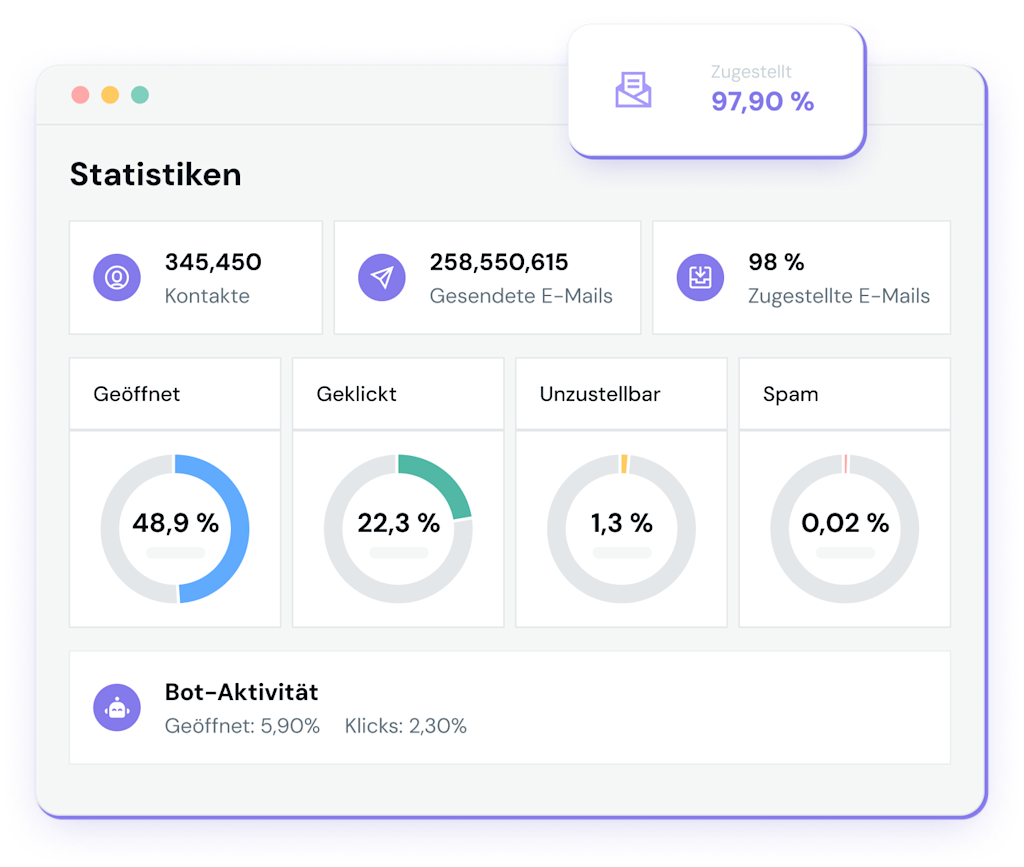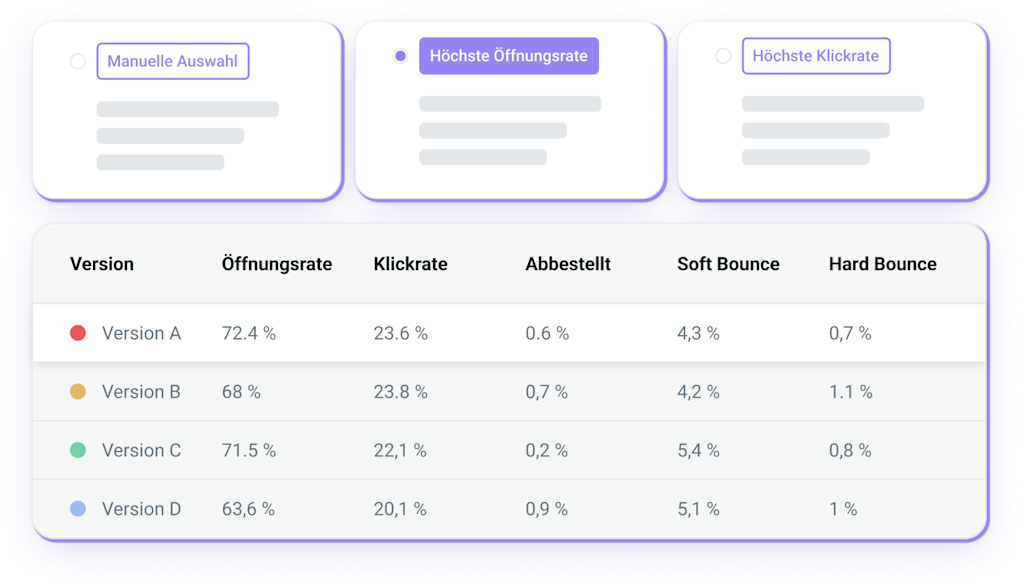E-Mail Marketing Lösung für kleine und mittlere Unternehmen
Responsive Marketing E-Mails und Transaktions-E-Mails zu erstellen, die wirklich erfolgreich sind, muss für kleine und mittlere Unternehmen kein Hexenwerk sein. Mit unserer E-Mail Marketing Software erstellen, versenden, überwachen und optimieren Sie alleine oder gemeinsam mit Ihrem Team E-Mail Marketing Kampagnen in wenigen Minuten.
Erstellen Sie in Minutenschnelle beeindruckende E-Mails
Erstellen Sie auf einfache Weise schöne, responsive E-Mails, die auf allen Geräten gut aussehen.
Stöbern Sie in unserer umfangreichen E-Mail-Vorlagengalerie mit über 50 Designs
Fordern Sie unseren KI-Vorlagengenerator auf, das Design, den Text und die Betreffzeilen für Ihre Kampagne zu erstellen.
Nutzen Sie unseren intuitiven Drag-and-drop-Editor und wenden Sie ganz einfach Ihr Markenstyling an, um es zu Ihrem eigenen zu machen.


DSGVO-KONFORMER E-MAIL LISTENAUFBAU
Gewinnen Sie neue E-Mail Abonnenten für Newsletter und Co.
Gewinnen Sie mit unseren DSGVO-konformen Anmeldeformularen und -widgets automatisiert neue Empfänger. Erstellen Sie dazu wahlweise ein integriertes Anmeldeformular oder Pop-Up per Drag-and-Drop und fügen dieses an passender Stelle auf Ihrer Webseite ein. Sie können bis zu 10 Felder in Ihr Anmeldeformular einbinden.
NEHMEN SIE JEDERZEIT ÄNDERUNGEN VOR
Bearbeiten Sie Kontakte und E-Mail Listen nachträglich
Mit der integrierten E-Mail Kontaktverwaltung legen Sie beliebig viele Kontaktlisten, Kontaktinformationen sowie benutzerdefinierte Werte an und bearbeiten Sie diese nachträglich. Sie zahlen natürlich nur für tatsächlich versendeten E-Mails und nicht nach Kontaktanzahl. Unsere E-Mail Marketing Software für KMUs verfügt über eine automatische E-Mail Adressbereinigung und Bouncen-Management und entfernt automatisch abgemeldete Nutzer, Hard Bounces und Spam-Beschwerden.


IMMER DAS PASSENDE E-MAIL DESIGN
Kostenlose E-Mail Vorlagen für jeden Einsatzweck
Wählen Sie aus einer Vielzahl an responsiven und rechtsfrei einsetzbaren E-Mail Vorlagen das passende Design für Ihr KMU-Unternehmen aus und passen es individuell an. Laden Sie Alternativ Ihr eigenes Layout hoch. Speichern Sie einzelne Abschnitte und verwenden Sie diese für unterschiedliche E-Mail Vorlagen, indem Sie diese einfach mit nur einem Klick in andere Templates einfügen.
INTELLIGENTE E-MAIL AUTOMATISIERUNG
Automatisieren Sie Ihre E-Mail Kommunikation und Versand
Betreiben Sie gezielte und erfolgreiche Lead- und Kundenpflege mittels E-Mail Automation, indem Sie Teile Ihre E-Mail Kommunikation vollständig automatisieren. Nutzen Sie hierzu unsere vorgefertigten Szenarien, die sich entlang der Customer Journey orientieren. Erstellen Sie Willkommensserien, Feedback-E-Mails, Geburtstags-E-Mails, Reaktivierungs-E-Mails, Warenkorbabbrecher-E-Mails uvm.


UMFANGREICHES E-MAIL TRACKING
E-Mail Performance in Echtzeit analysieren
Erfahren Sie wie jeder einzelne Empfänger wie genau mit Ihren E-Mails interagiert. Mit unserer E-Mail Marketing Software für KMUs haben Sie alle wichtigen E-Mail Statistiken, darunter Zustellbarkeits-, Öffnungs-, Klickrate-, Spam-, Bounce- und Abmelderate uvm. stets im Blick.
UMFANGREICHE A/B TESTS
Testen Sie verschiedene Versionen Ihrer E-Mail
Unsere E-Mail Marketing Software für KMUs erlaubt es Ihnen, bis zu 10 Versionen Ihrer E-Mail zu testen und herauszufinden, welche Version bei Ihren Empfängern am besten funktionieren. Senden Sie Ihrer E-Mail an einer kleineren zufällig ausgewählten Testgruppe oder an die gesamte E-Mail Liste.


VORSCHAU UND TESTVERSION
Überprüfen Sie fertige E-Mail Vorlagen auf Fehler hin
Vor dem Abschicken sehen Sie in unserem Mailing Porgramm eine Vorschau der E-Mail Vorlage - und zwar exakt so, wie Ihre Empfänger diese im Posteingang vorfinden werden. Senden Sie sich zusätzlich eine Test-E-Mail an bis zu 10 E-Mail Adressen zu, um wirklich sicher zu sein. Auf diese Weise stellen Sie sicher, dass Ihre E-Mails immer so aussehen wie Sie dies auch beabsichtigen.
EINE VIELZAHL AN INTEGRATIONEN STEHEN BEREIT
Integrieren Sie Mailjet mit Ihren Tools
Unsere E-Mail Marketing Lösung für kleine und mittlere Unternehmen lässt sich in über 80 Anwendungen und Tools integrieren. So stellen Sie ganz einfach eine Verbindung zu Ihrer E-Commerce-Plattform, Ihrem CRM oder Ihrer Webseite her.


